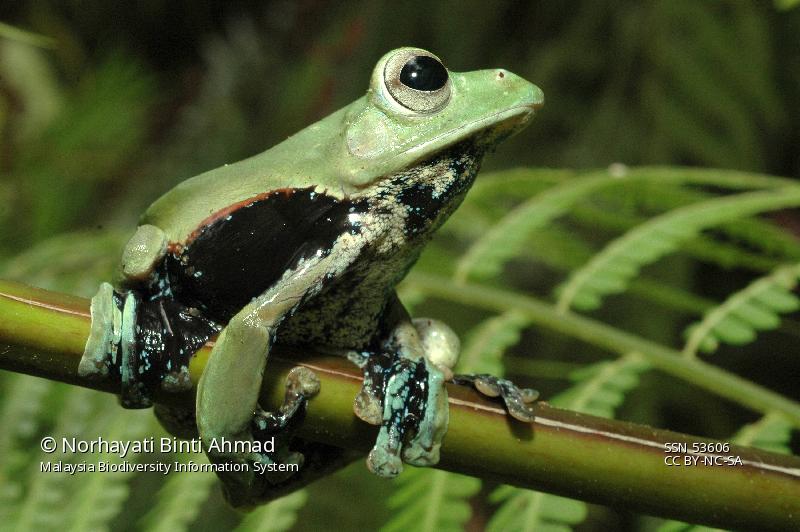
Norhayati’s Gliding Frog or Rhacophorus norhayatiae is an arboreal tree frog that can be widely found in Peninsular Malaysia. This species is in the family Rhacophoridae which in Malaysia are comprised of tree frogs (genus of Polypedates, Rhacophorus, Theloderma), flying frogs (genus Rhacophorus), bush frogs (genus Philautus), and the Cinnamon frog (Nyctixalus pictus).
Rhacophorus norhayatiae was only described in 2010. Initially, the frog was identified as Reinwardti's Flying Frog (Rhacophorus reinwardtii). However, when Chan and Grismer (2010) reassessed R. reinwardtii populations in Southern Thailand and Peninsular Malaysia, they found that these populations were morphologically dissimilar from the populations first described from Javan and Bornean populations; hence this is a new species. Rhacophorus norhayatiae can be differentiated from R. reinwardtii by a larger maximum snout-vent length (SVL) in males (64.7 mm vs. 55mm), lack of spots on the dorsum, higher degree of interdigital webbing, pigmentation on hands and feet, and rusty brown markings on the flanks. The specific epithet norhayatiae honours Professor Dr Norhayati Ahmad of the National University of Malaysia (UKM) (Chan & Grismer, 2010).
An adult male R. norhayatiae can grow up to 64.7 mm in length while the female can reach up to 83 mm (Chan & Grismer, 2010). It has a flattened head with a pointed snout while both head length and width are about equal. The tympanum is distinct and its diameter is about three-quarters of the horizontal width of the eye. It has smooth dorsal skin, but the skin above its belly, the side of the body and lower surface of its thighs are coarsely granular. There is no dorsolateral fold. This frog is easily distinguishable on the basis of its colours. In the adult frog, the dorsal surface is a uniform bright green, lacking spots or other markings. The underside of the body and throat are white to pale grey, mottled with small dark spots. It is typical for genus Rhacophorus to have fully webbed hands and feet; the webbing is blue and black in R.norhayatiae.
Rhacophorus norhayatiae inhabits lowland and hill forest, living on trees up to 7 m above the forest floor, next to temporary water bodies such as pools and puddles and in water-filled tyre tracks on logging roads (Chan & Grismer, 2010). Its call has been described as rattling and woodpecker-like (Chan & Grismer, 2010). Habitually, the frog can be found up to 550 m above sea level, but some have been found at 1500 m above sea level in Tanah Rata, Cameron Highlands, Pahang (Berry, 1975). Apart from Peninsular Malaysia, it also occurs in the extreme south and a small area of west-central Thailand, near the border with Myanmar (Dring, 1979; Chan-ard, 2003). The conservation status of R. norhayatiae has still not been assessed under International Union for Conservation of Nature (IUCN) but it is believed that the frog requires immediate conservation action due to heavy deforestation and habitat loss occurring within its distribution range.
